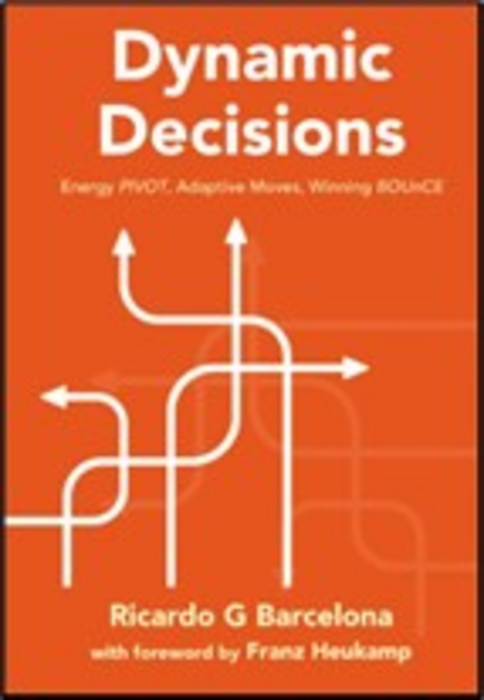Dynamic Decisions responds to addressing wicked problems that confront real people. Critiqued by two of modern financial economics’ leading thinkers, Avinash Dixit and Barry Nalebuff see some managers as behaving like woodcutters when evaluating their investments. Some managers treat markets and competitors like trees that do not react as the woodcutter chops to maximise their pile of wood. To enhance efficiency, they sharpen their axe and assume that they could sell all their output. Under dynamic markets, however, rival firms tend to behave like opposing armies that do not sit still to be mowed down by superior force. Instead, rival firms would respond to outcompete or frustrate the adversary’s moves. An astute manager, behaving like a general, surveys the field, understands the terrain and context, and weighs their options prior to choosing the battles to contest.

Credit: World Scientific
Dynamic Decisions responds to addressing wicked problems that confront real people. Critiqued by two of modern financial economics’ leading thinkers, Avinash Dixit and Barry Nalebuff see some managers as behaving like woodcutters when evaluating their investments. Some managers treat markets and competitors like trees that do not react as the woodcutter chops to maximise their pile of wood. To enhance efficiency, they sharpen their axe and assume that they could sell all their output. Under dynamic markets, however, rival firms tend to behave like opposing armies that do not sit still to be mowed down by superior force. Instead, rival firms would respond to outcompete or frustrate the adversary’s moves. An astute manager, behaving like a general, surveys the field, understands the terrain and context, and weighs their options prior to choosing the battles to contest.
Battle tested managers recognise that their world is changing, perhaps even radically. However, to guide their investment decisions, managers are equipped with tools that favour the predictable and proven. This leads managers to misdiagnose the ignored risks or opportunities implicit in the estimated payoffs. To remedy this, Dr Ricardo G Barcelona proposes in Dynamic Decisions counter-intuitive approaches that provoke radical re-examination of the “accepted wisdoms”. To wit: As the dominant players’ perceived advantages obsolesce, new entrants could disrupt extant network relationships and sources of competitive edge. To enhance their prospects, competing firms could repurpose, reframe, and reconfigure their resources and processes to shift emerging competitive advantages in their firm’s favour.
Dynamic Decisions describes how managers could orchestrate their strategic moves. The insights provoke deep re-examination of “accepted wisdoms” with sparse evidence that it actually worked. Examine, for example, the following:
- Similar investments that work in one market could fail in another subject to the firm’s initial positions, the strength and nature of rival firms’ responses, and market structures.
- Subsidies for renewables result in radically different outcomes that are often opposed to what policy intended, or what managers expected.
- Rapid declines in photovoltaic solar power costs penalise aggressive early movers, often with bankruptcy, while conferring late-movers with benefits or windfalls.
- Continual upgrades, hence enhancing operational efficiency, of obsolescing fossil fuel assets hasten its demise, while benign neglect may lengthen its longevity.
- Human virtues and beliefs, when explicitly considered, unlock insights on how creative humans innovate to reshape society and avoid predetermined demise or extinction.
- In pushing for “one political solution that fits all”, policy is often predestined to fail.
- Firms could avoid bearing undue burdens by reconfiguring its business out of any adverse regulatory scope, or defer actions while awaiting changes in policy stance.
Under this dynamic context, extant capital budgeting tools are ill equipped to correctly inform managerial decisions. To remedy, Dr Barcelona draws lessons from real life business cases to propose a three-prong PIVOT to a winning BOUnCE. Dynamic Decisions encapsulates under PIVOT and BOUnCE a viable decision framework.
In contrasting what Dynamic Decisions proposes approaches that complement what capital budgeting prescribes, or make explicit what is ignored. Franz Heukamp, Dean of IESE Business School observes in his foreword how Dynamic Decisions could enhance the firm’s strategic moves: “In Ricardo’s formulation, he sees a decision ecosystem that is inherently dynamic. In this world, how managers shape their business and respond to policy’s actions and their rival’s strategic moves interact to influence outcome”. This contrasts with what perhaps a vast majority of managers value: Predictable, known, proven cash flows are valued more than ambiguous outcomes. Paradoxically, “proven technologies are preferred over innovative approaches that may disrupt the status quo. Partly, the unknowns are to be feared and mitigated as risks, not as a source of opportunities to create tomorrow’s profitable niches”, Heukamp added.
Dynamic Decisions: Energy PIVOT, Adaptive Moves, Winning BOUnCE retails for US$98 / £80 (hardcover) and is also available in electronic formats. To order or know more about the book, visit http://www.worldscientific.com/worldscibooks/10.1142/Q0353.
###
About the Author
Ricardo G. Barcelona authored two ground-breaking books on energy: Energy Investments (2017) values renewables as real options under interacting energy portfolios and oligopolistic rivalries; and Dynamic Decisions (2022) explicitly recognises how imperfect humans could orchestrate resilience in firms to achieve a sustainable and profitable future. Through his research and interactions with academe, businesses, and policy experts, he contributes to conversations around energy transitions and sustainability, decisions under uncertainties, and how imperfect humans creatively reshape their businesses and society. His insights benefit from his academic rigour, senior leadership experiences at Royal Dutch Shell, Netherlands and London, and the City of London. As an investment banker, he was consistently voted the top-rated equity analyst and adviser for European utilities while at SBC Warburg and ABN AMRO/Rothschild. He obtained his PhD in Management from King’s College London, United Kingdom, MBA from IESE Business School, Spain, and BA from the School of Economics, University of the Philippines.
About World Scientific Publishing Co.
World Scientific Publishing is a leading international independent publisher of books and journals for the scholarly, research and professional communities. World Scientific collaborates with prestigious organisations like the Nobel Foundation and US National Academies Press to bring high quality academic and professional content to researchers and academics worldwide. The company publishes about 600 books and over 150 journals in various fields annually. To find out more about World Scientific, please visit www.worldscientific.com.
For more information, contact WSPC Communications at [email protected].
DOI
10.1142/q0353




